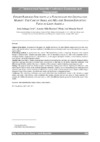Please use this identifier to cite or link to this item:
https://accedacris.ulpgc.es/jspui/handle/10553/76026
| Title: | Export barriers perceived as a function of the destination market: the case of small and mid-size spanish exporting firms to Latin America | Authors: | Arteaga Ortiz, Jesús Mihi Ramírez, Antonio Miranda Martel, María José |
UNESCO Clasification: | 5311 Organización y dirección de empresas | Keywords: | Empirical-Analysis Internationalization States Performance Expansion, et al |
Issue Date: | 2016 | Conference: | 21st International Scientific Conference on Smart and Efficient Economy - Preparation for the Future Innovative Economy | Abstract: | Purpose of the article The purpose of this paper is to identify and discuss the export barriers, propose and test a new scale, and to verify that the relative importance attributed to the different export obstacles could vary as a function of the company's export market.Methodology/methods A questionnaire was sent to 2590 Spanish firms related to exporting. Responses were analyzed through a dimensionality reduction procedure (from a list of individual obstacles) to yield seven composite factors: knowledge barriers, exogenous barriers, cultural barriers, private support and logistics barriers, customs barriers, resources-based barriers, and market adaptation barriers.Scientific aim Since there is neither a homogeneous number of existing barriers and types nor a uniform criterion of relative importance, typology and scales to embrace them, we contribute to shed light on the relative importance attributed to the different export barriers and how they vary as a function of the company's export destination, proposing a new scale.Findings The proposed model was finally accepted and interesting findings were achieved regarding the differences in the export barriers faced by firms in the different destination territories. Findings such as transportation costs being the lowest perceived trade barrier in Latin America or tariff barriers scoring similar in Latin America than in Europe (while being a European Custom Union) create a ground for new studies and discussions on international trade.Conclusions This study helps understand some aspects which have been insufficiently covered in the literature on export barriers and makes some findings which compliment the existing literature and sets new paths for future researchs. For example, the validity and relevance of the new scale, as well as the different obstacles perceived, based on the export's final market. | URI: | https://accedacris.ulpgc.es/handle/10553/76026 | Source: | Smart and efficient economy: preparation for the future innovative economy, p. 586-594, (2016) |
| Appears in Collections: | Actas de congresos |
Page view(s)
92
checked on Aug 3, 2024
Download(s)
51
checked on Aug 3, 2024
Google ScholarTM
Check
Share
Export metadata
Items in accedaCRIS are protected by copyright, with all rights reserved, unless otherwise indicated.
